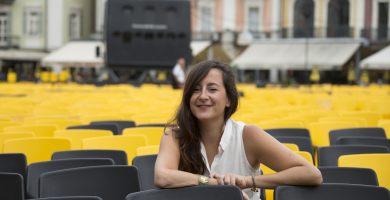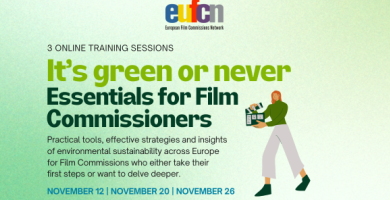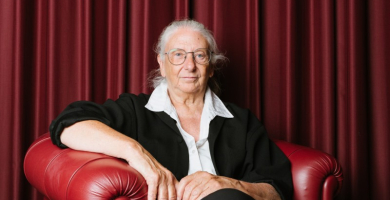
Laura Herrero: “For me above all the most important when directing, is to know how you want to look and where you want to look at.”
This month we interview Laura Herrero Garvín from Toledo, director of the documentary La Mami which was released last month in our cinemas.

We were able to see the film for the first time a year ago at the D’A Film Festival just when the pandemic was beginning to hit us. Herrero built her career as a documentary filmmaker in Mexico and this is her first coproduction with Spain. We talk with her about La Mami and about her career in the world of documentary films.
When did you decide that you wanted to devote yourself to documentary films? If it was a conscious decision at some time.
In Spain I studied telecommunications engineering specialized in image and sound. I then travelled the world a lot and participated in many academic exchanges. I have always liked audiovisual. Therefore, when I lived for a time in the States after completing the degree, I began to study film, which was something that had attracted my attention for some time. I am from a very small village in Toledo, from a very humble family. And I was attracted by the cinema. For a girl like me it was very difficult to dream about working in this. In the States, I began to do film workshops and courses and I went to live in Mexico with the idea of focusing on filmmaking. I took an intensive course in filmmaking. There I became involved in a social movement and this was a key for me.
In 2011, with the death of a poet’s son in Mexico, a very strong social movement broke out called Movement for Peace with Justice and Dignity, made up of the relatives of those murdered or disappeared. Instinctively, a group of us with cameras in the city where it happened, Cuernavaca, got together and began to film. I went with the camera that I had just bought. Together we created a group which was called Emergency MX and we followed this social movement for just over a year. There I realized that documentary filmmaking was a tool that could fulfil all my professional and creative, but also my ideological and political desires, and that it was something powerful and really wonderful. I knew that it was what I wanted to do in life. Since then, I have not stopped.
Do you see audiovisual as a tool for participation and commitment, for denunciation?
I began to do filmmaking through political and social films and this is something very clear for me. For me, at that time, it was a really powerful tool to immortalize, to make an explosion, for what we were seeing through our cameras to reach many more places. To become viral. Then, starting from that social movement and that group, we were seven women who were doing other things and we created La Sandía, a feminist group working with documentary films from a gender perspective and focused on human rights, feminist cinema. With time, I had more connections with film d’auteur, which called for something more subjective and which is more related to the essence and not so much with a more social outlook. Although I believe that everything personal is political and social. In the work that I am doing now, my filmmaking does not have such a strong point of vindication, although it is there; it has a more subjective and personal connection. In the end, like all art, it transgresses, it puts things on the table and this means that in a certain way they change socially and politically.
You built a large part of your career in Mexico and your films have been produced or coproduced there. Why and what is Mexico for you?
I always say that Mexico is a country which has made me see life in its pure state. On walking in Mexico, experiencing Mexico, travelling in Mexico and looking into its eyes, I have seen the most putrid and disgusting things of my life, but also the brightest and most hopeful. Having all this on the table makes you much more alert, more attentive, and this means that the creative space is highly alive and present. This is very important for me. Mexico has given me all this liveliness and this desire to live, to relate and to portray what I had before me through documentary film.
How did you discover the character of La Mami and how did the idea of making a documentary about her and the Barba Azul cabaret arise?
It arose from a night of partying with a friend. I was putting together my first film, El remolino, and a musician friend, who ended up doing the music for the film, said to me: “I must take you somewhere that you’re going to love. They play live salsa, cumbia, boleros…”. I really like to dance. That night, one of the times when I went to the washroom, I met La Mami. She wasn’t very friendly, but then I began to hear how the girls who worked there as hostesses talked to her: “Mami, I’m falling in love with this client. Mami, I’m tired. Mami, what does this dress look like?”. La Mami watched over them, and I began to understand how important this woman was in that space. That same night I approached her and told her that I was devoted to making documentaries and that I was interested in discovering her story and getting to know her a little better. And she said to me: “If you want come tomorrow at nine”. And that’s how it all began, although it was then a process which lasted five years.
A documentary like that requires creating a relationship of trust both with La Mami and with the girls. What was this process of getting to know them and getting closer to them like?
They are women who are subject to stigma and considerable prejudice. I also wanted to make an intimate and close film, which was not frivolous and did not suppose anything, but which went beyond all that. It was important to bear this in mind and to know that the research process was going to take much longer than I had imagined. I was visiting them for almost 3 years to gain their trust. It was also important to offer them different ways of appearing in the film: they could decide not to appear, just have their voice or their voice and body, but without their face, or with everything. It was important that they could choose how to participate.
The whole film takes place in a small space, the washroom of the Barba Azul cabaret, not in the room but in the relations that are established in a small space between La Mami and the girls. Bearing this in mind, how did you approach the directing of the documentary?
I was attracted by the washroom. I always thought that it was the centre of everything, of the conversations… I spent a lot of time there observing, listening. The centre of the film was La Mami, but then this new character of Priscilla emerged, who also became the centre, and the film became a meeting space between them. Whenever I approach a documentary, I like to give everything to the process. During this process, you take formal decisions which help you to understand where you are going.
This film takes place between this washroom in bright, ochre colours, where the camera is going to be the least intrusive, observing the space of the word. And the dance floor, where the camera is much more subjective; it interacts, it is the space of body language and where the women exhibit themselves the most. There is the voice of the man, the singer who sings about romantic love, jealousy, passion. It was very important to understand how to divide the narrative between these two spaces. Between the women’s washroom and the dance floor and these stairs which let them move from one place to the other. When you begin to make formal decisions about this, it really helps to hold the gaze in the film and it is also important, for me above all the most important when directing, to know how you want to look and where you want to look, who you want to look at. Starting from there, you don’t get lost looking at many places, but rather you direct your gaze if you know where you’re going.
What were the greatest difficulties that you had to confront during the shoot?
Above all, at the beginning, it was complicated getting the girls to participate. It is true that the women’s washroom was a challenge because there were thousands of mirrors, but then I got so used to it that it all came together. There was also a very important challenge with the noise; there was a lot and there was also that which came from below. And then creating a dialogue which took place between four walls with a woman who is seated for most of the time as the centre and with these girls who go in and out. This frenetic night, which flows a lot, letting yourself go with them.
We imagine that the editing was also fundamental for the film. What was the process?
There were two parts. One with Lorenzo Mora who was the editor of my first film. We worked in Mexico at the same time as filming. We shot, we went to the editing room and we thought. Then, over the following days of filming I understood better where we could go. There were many spaces for reflection with Lorenzo. The film was shot thinking a lot about how it was going to be edited, and therefore there are lots of shots/reverse shots and off screen shots which are constructed around La Mami, Priscilla and the girls who do show their face.
In December I decided to return to Barcelona. Here we continued the editing with the Catalan film editor Ana Pfaff. We gave it a sort of second round, with internal times and ellipsis, which was extremely important. Ana knew how to put the final touch. With her we made the film depend much more on the washroom and we were able to build up all the tension with the looks.
The film was premiered at last year’s D’A in online format because of the pandemic. How did this healthcare situation affect you?
The worldwide premiere was in the official selection of IDFA in Amsterdam, which is the world’s biggest documentary festival. On being in the official selection it had a huge repercussion and the film began to fly a lot. We then released it in Sweden, Finland, the States, in the MOMA of New York. We were going to South by Southwest, Guadalajara… In March, April and May we were going to very many places and the pandemic affected us a great deal, because we were riding on the crest of the wave. It’s true that we were soaring a lot, but we didn’t crash. The film has continued to fly. It’s true that when you make a film, you dream that it will be seen on the big screen. It has therefore been difficult to understand that this couldn’t be the case. But anyway, we released it in Spain in cinemas on 5 March and it has gone very well. It will have its route on a more cultural circuit and we will look at the options. For me it is very important for people to see it in cinemas, because the perception of the film changes a lot. We released it in Mexico, and also in the States. But the pandemic inevitably affected us.
Is it difficult to find distribution for a documentary project?
Yes. People are more used to watching fiction than documentaries, above all documentary films. There is a collective view of what a documentary is which is something else; it is confused with a news report. There is a very fine and confusing thread which is starting to break. This year was a very good year for documentaries. Very powerful films have been released and it is wonderful that there has been all this repercussion. La Mami is being very well received and there are forums on which the audience likes to see documentaries. There are also documentaries like this one, which shows that the thin line is not between a news report and a documentary, but between the documentary and fiction. A very common question in the discussions about La Mami is: “But, is it a documentary or is it fiction?”. People are confused because there is a level of closeness with the characters which means that suddenly they don’t understand that it is a documentary. I believe that the audience appreciates this and that is important.
The film formed part of the Ibermedia project, the coproduction stimulus programme, in 2017. What importance do you think that this type of programmes has for more independent cinema?
We would never have had a coproduction with Spain without Ibermedia. In the end, it is inevitable that the funds really set the pace and a little the essence of a film. I do not mean from a narrative viewpoint, but as regards production times, the partnerships that you form and which then affect other things. I do not know whether the film would have had Spanish distribution or if we would have been nominated for the Gaudí awards, if we hadn’t had a coproduction with Spain. And this occurred thanks to Ibermedia, because in the end, the funding from Spain comes from Ibermedia and little more.
Is funding the main problem when it comes to making a documentary?
I think that it is very complicated in Spain when you are starting out as a documentary filmmaker or you are making your debut films. It’s true that I funded my films in Mexico and that it’s a little different there. In Mexico, there is much more encouragement for new directors and here it is much harder to make a film if you are a new director and you are moreover with a new production company. This points system, which means that the greater your seniority the more points you have, means that it is more difficult for those of us who are starting out. Well, I don’t consider that I’m starting out any more, because I have two films, but it is true that it’s much more complicated for people starting out.
Before you mentioned that one of the subjects that you tend to address in your films is that of women. On concentrating your career in Mexico, is it more difficult to obtain funding for a project in which women are the main characters or is less attention paid to stories of women?
It’s been difficult to find funding in general. Maybe it was because the film was radically feminist, with no men. It may be, but I’m not sure whether that is 100% the reason. There are now a lot of documentary films made by women. And in the end as women, we look at women quite a lot because we identify with them. I do not think that this is the problem. In the end documentary films are still on the sidelines of funding. We do not have big budgets. When you work on the sidelines you can do madder and freer things. You may encounter fewer obstacles. If they gave me €5 million to make a feature length film in a washroom where there weren’t any men, I’m sure I would have more problems. But as that wasn’t the case.
What’s your next project? Have you already got a new documentary under way?
I am at a very early stage of writing something new, a sort of hybrid between a documentary and fiction. Very close to fiction. I don’t want to say any more because it’s at a very early stage. It’s about women, about encounters, and it will be shot in Spain.










